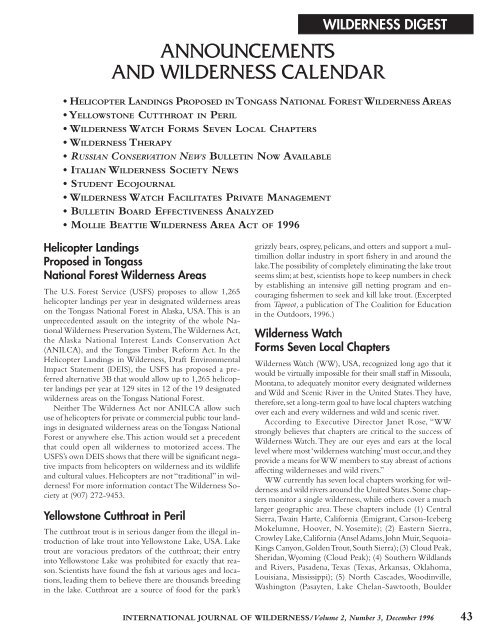P3-Vol 2.No3 Dec 96 - International Journal of Wilderness
P3-Vol 2.No3 Dec 96 - International Journal of Wilderness
P3-Vol 2.No3 Dec 96 - International Journal of Wilderness
Create successful ePaper yourself
Turn your PDF publications into a flip-book with our unique Google optimized e-Paper software.
ANNOUNCEMENTS<br />
AND WILDERNESS CALENDAR<br />
• HELICOPTER LANDINGS PROPOSED IN T ONGASS NATIONAL FOREST W ILDERNESS AREAS<br />
• YELLOWSTONE CUTTHROAT IN PERIL<br />
• WILDERNESS WATCH FORMS SEVEN LOCAL CHAPTERS<br />
• WILDERNESS THERAPY<br />
• RUSSIAN CONSERVATION NEWS BULLETIN NOW AVAILABLE<br />
• ITALIAN WILDERNESS SOCIETY NEWS<br />
• STUDENT ECOJOURNAL<br />
• WILDERNESS WATCH FACILITATES PRIVATE MANAGEMENT<br />
• BULLETIN BOARD EFFECTIVENESS ANALYZED<br />
• MOLLIE BEATTIE WILDERNESS AREA ACT OF 19<strong>96</strong><br />
Helicopter Landings<br />
Proposed in Tongass<br />
National Forest <strong>Wilderness</strong> Areas<br />
The U.S. Forest Service (USFS) proposes to allow 1,265<br />
helicopter landings per year in designated wilderness areas<br />
on the Tongass National Forest in Alaska, USA. This is an<br />
unprecedented assault on the integrity <strong>of</strong> the whole National<br />
<strong>Wilderness</strong> Preservation System, The <strong>Wilderness</strong> Act,<br />
the Alaska National Interest Lands Conservation Act<br />
(ANILCA), and the Tongass Timber Reform Act. In the<br />
Helicopter Landings in <strong>Wilderness</strong>, Draft Environmental<br />
Impact Statement (DEIS), the USFS has proposed a preferred<br />
alternative 3B that would allow up to 1,265 helicopter<br />
landings per year at 129 sites in 12 <strong>of</strong> the 19 designated<br />
wilderness areas on the Tongass National Forest.<br />
Neither The <strong>Wilderness</strong> Act nor ANILCA allow such<br />
use <strong>of</strong> helicopters for private or commercial public tour landings<br />
in designated wilderness areas on the Tongass National<br />
Forest or anywhere else. This action would set a precedent<br />
that could open all wilderness to motorized access. The<br />
USFS’s own DEIS shows that there will be significant negative<br />
impacts from helicopters on wilderness and its wildlife<br />
and cultural values. Helicopters are not “traditional” in wilderness!<br />
For more information contact The <strong>Wilderness</strong> Society<br />
at (907) 272-9453.<br />
Yellowstone Cutthroat in Peril<br />
The cutthroat trout is in serious danger from the illegal introduction<br />
<strong>of</strong> lake trout into Yellowstone Lake, USA. Lake<br />
trout are voracious predators <strong>of</strong> the cutthroat; their entry<br />
into Yellowstone Lake was prohibited for exactly that reason.<br />
Scientists have found the fish at various ages and locations,<br />
leading them to believe there are thousands breeding<br />
in the lake. Cutthroat are a source <strong>of</strong> food for the park’s<br />
WILDERNESS DIGEST<br />
grizzly bears, osprey, pelicans, and otters and support a multimillion<br />
dollar industry in sport fishery in and around the<br />
lake. The possibility <strong>of</strong> completely eliminating the lake trout<br />
seems slim; at best, scientists hope to keep numbers in check<br />
by establishing an intensive gill netting program and encouraging<br />
fishermen to seek and kill lake trout. (Excerpted<br />
from Taproot, a publication <strong>of</strong> The Coalition for Education<br />
in the Outdoors, 19<strong>96</strong>.)<br />
<strong>Wilderness</strong> Watch<br />
Forms Seven Local Chapters<br />
<strong>Wilderness</strong> Watch (WW), USA, recognized long ago that it<br />
would be virtually impossible for their small staff in Missoula,<br />
Montana, to adequately monitor every designated wilderness<br />
and Wild and Scenic River in the United States. They have,<br />
therefore, set a long-term goal to have local chapters watching<br />
over each and every wilderness and wild and scenic river.<br />
According to Executive Director Janet Rose, “WW<br />
strongly believes that chapters are critical to the success <strong>of</strong><br />
<strong>Wilderness</strong> Watch. They are our eyes and ears at the local<br />
level where most ‘wilderness watching’ must occur, and they<br />
provide a means for WW members to stay abreast <strong>of</strong> actions<br />
affecting wildernesses and wild rivers.”<br />
WW currently has seven local chapters working for wilderness<br />
and wild rivers around the United States. Some chapters<br />
monitor a single wilderness, while others cover a much<br />
larger geographic area. These chapters include (1) Central<br />
Sierra, Twain Harte, California (Emigrant, Carson-Iceberg<br />
Mokelumne, Hoover, N. Yosemite); (2) Eastern Sierra,<br />
Crowley Lake, California (Ansel Adams, John Muir, Sequoia-<br />
Kings Canyon, Golden Trout, South Sierra); (3) Cloud Peak,<br />
Sheridan, Wyoming (Cloud Peak); (4) Southern Wildlands<br />
and Rivers, Pasadena, Texas (Texas, Arkansas, Oklahoma,<br />
Louisiana, Mississippi); (5) North Cascades, Woodinville,<br />
Washington (Pasayten, Lake Chelan-Sawtooth, Boulder<br />
INTERNATIONAL JOURNAL OF WILDERNESS/<strong>Vol</strong>ume 2, Number 3, <strong>Dec</strong>ember 19<strong>96</strong> 43










